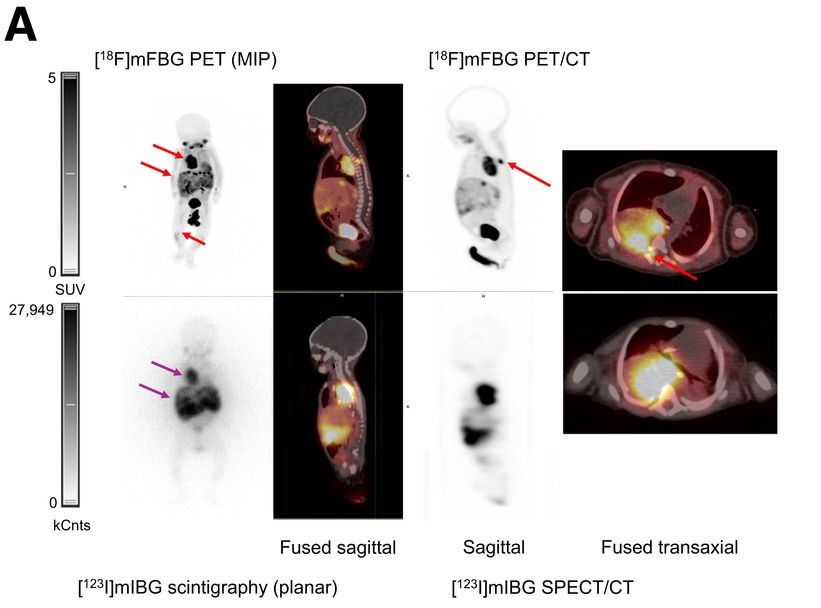Molecular Imaging Technique Accurately Detects Neuroblastoma in Children With Short Scan Time, No Anesthesia
Images

A new molecular imaging technique that pairs a novel tracer with a next-generation PET/CT scanner can identify neuroblastoma in children with high sensitivity, requiring a scan time of only minutes and no sedation or anesthesia. With its ability to accurately diagnose neuroblastoma, the technique,18F-MFBG LAFOV PET/CT, has the potential to impact therapeutic decision-making for children with this disease. This research was published in the August issue of The Journal of Nuclear Medicine.
Neuroblastoma is the most common extracranial solid tumor in children, with an overall survival of 70%. For decades,123I-MIBG SPECT/CT has been the standard of care for initial staging, response assessment, and frequently used follow-up of neuroblastoma.
The123I-MIBG SPECT/CT scanning procedure is a two-day protocol. Sedation or general anesthesia is frequently used because the patients are predominantly infants and due to the lengthy scan time, often more than two hours.
“For young children undergoing molecular imaging, less exposure to radiation and the avoidance of sedation or general anesthesia is very important,” said Lise Borgwardt, MD, PhD, senior consultant in pediatric nuclear medicine at Copenhagen University Hospital-Rigshospitalet, in Copenhagen, Denmark. “In our study, we used the tracer18F-MFBG which requires only a one-day protocol, at the long-axial-field-of-view (LAFOV) PET/CT scanner, which has a sensitivity about 10 times higher than a digital PET/CT scanner. We then compared this technique with123I-MIBG SPECT/CT to determine its diagnostic value and feasibility.”
The study included 10 children with neuroblastoma who received123I-MIBG SPECT/CT followed by18F-MFBG LAFOV PET/CT. Masked readers independently scored the123I-MIBG and18F-MFBG scans for the presence of any pathologic lesions. SIOPEN and Curie scores (semi-quantitative systems used to assess metastatic disease burden) were also calculated.
None of the children required sedation or general anesthesia with18F-MFBG LAFOV PET/CT, whereas 80% had general anesthesia with123I-MIBG SPECT/CT. In addition, a PET acquisition time of only two minutes without motion artifacts was required for reconstruction to provide a clinically useful image with18F-MFBG LAFOV PET/CT.
Eighty percent of18F-MFBG LAFOV PET/CT scans revealed more lesions than123I-MIBG SPECT/CT scans and 20% revealed the same number of lesions. In18F-MFBG LAFOV PET/CT scans, the SIOPEN score was higher in 50% of the cases, and the Curie score was higher in 70% of the cases. Intraspinal involvement, retroperitoneal lymph node involvement, and bone marrow involvement were diagnosed with much higher precision with18F-MFBG LAFOV PET/CT.
“A scan with a much higher sensitivity can find very small lesions and the exact extension in the body and can be extremely beneficial in determining the right course of treatment,” said Borgwardt. “The fact that these scans can be performed without anesthesia or sedation, and at a lower radiation dose is a big step forward for the children, parents, and the healthcare system in general.”